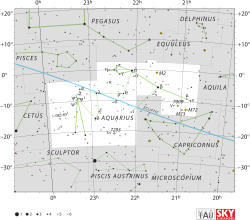Upsilon Aquarii
Appearance
| Observation data Epoch J2000 Equinox J2000 | |
|---|---|
| Constellation | Aquarius |
| Right ascension | 22h 34m 41.63641s[1] |
| Declination | –20° 42′ 29.5779″[1] |
| Apparent magnitude (V) | +5.21[2] |
| Characteristics | |
| Spectral type | F5 V[3] |
| B−V color index | +0.44[2] |
| Astrometry | |
| Radial velocity (Rv) | –5.2[4] km/s |
| Proper motion (μ) | RA: +220.78[1] mas/yr Dec.: –146.76[1] mas/yr |
| Parallax (π) | 44.09 ± 0.26 mas[1] |
| Distance | 74.0 ± 0.4 ly (22.7 ± 0.1 pc) |
| Absolute magnitude (MV) | +3.44[4] |
| Details | |
| Surface gravity (log g) | 4.11[3] cgs |
| Temperature | 6,597[3] K |
| Metallicity [Fe/H] | –0.04[3] dex |
| Rotational velocity (v sin i) | 34.9[5] km/s |
| Age | 0.9[4] Gyr |
| Other designations | |
| Database references | |
| SIMBAD | data |
Upsilon Aquarii (υ Aqr, υ Aquarii) is the Bayer designation for a binary star[7] in the equatorial constellation of Aquarius. It is a faint naked eye star with an apparent visual magnitude of 5.21.[2] Parallax measurements give a distance estimate of 74.0 light-years (22.7 parsecs) from Earth.[1] This is a high proper-motion star.[6]
Upsilon Aquarii is an F-type main sequence star with a stellar classification of F5 V.[3] With an effective temperature of 6,597,[3] it shines with the yellow-white hue of an F-type star.[8] An orbiting companion star was detected in 2007 at the Gemini Observatory.[7]
References
- ^ a b c d e f van Leeuwen, F. (November 2007), "Validation of the new Hipparcos reduction", Astronomy and Astrophysics, 474 (2): 653–664, arXiv:0708.1752, Bibcode:2007A&A...474..653V, doi:10.1051/0004-6361:20078357.
- ^ a b c Johnson, H. L.; et al. (1966), "UBVRIJKL photometry of the bright stars", Communications of the Lunar and Planetary Laboratory, 4 (99), Bibcode:1966CoLPL...4...99J.
- ^ a b c d e f Gray, R. O.; et al. (July 2006), "Contributions to the Nearby Stars (NStars) Project: spectroscopy of stars earlier than M0 within 40 pc-The Southern Sample", The Astronomical Journal, 132 (1): 161–170, arXiv:astro-ph/0603770, Bibcode:2006AJ....132..161G, doi:10.1086/504637.
- ^ a b c Nordström, B.; et al. (May 2004), "The Geneva-Copenhagen survey of the Solar neighbourhood. Ages, metallicities, and kinematic properties of ˜14 000 F and G dwarfs", Astronomy and Astrophysics, 418: 989–1019, arXiv:astro-ph/0405198, Bibcode:2004A&A...418..989N, doi:10.1051/0004-6361:20035959.
- ^ Schröder, C.; Reiners, A.; Schmitt, J. H. M. M. (January 2009), "Ca II HK emission in rapidly rotating stars. Evidence for an onset of the solar-type dynamo" (PDF), Astronomy and Astrophysics, 493 (3): 1099–1107, Bibcode:2009A&A...493.1099S, doi:10.1051/0004-6361:200810377.
- ^ a b "* ups Aqr". SIMBAD. Centre de données astronomiques de Strasbourg. Retrieved 2012-07-03.
{{cite web}}: CS1 maint: postscript (link) - ^ a b Lafrenière, David; et al. (2007), "The Gemini Deep Planet Survey", The Astrophysical Journal, 670 (2): 1367–1390, arXiv:0705.4290, Bibcode:2007ApJ...670.1367L, doi:10.1086/522826.
- ^ "The Colour of Stars", Australia Telescope, Outreach and Education, Commonwealth Scientific and Industrial Research Organisation, December 21, 2004, retrieved 2012-07-02.

